 |
| February 06, 2018 | Volume 14 Issue 05 |
Designfax weekly eMagazine
Archives
Partners
Manufacturing Center
Product Spotlight
Modern Applications News
Metalworking Ideas For
Today's Job Shops
Tooling and Production
Strategies for large
metalworking plants
Wheels:
Bugatti brake caliper is world's largest 3D-printed titanium component
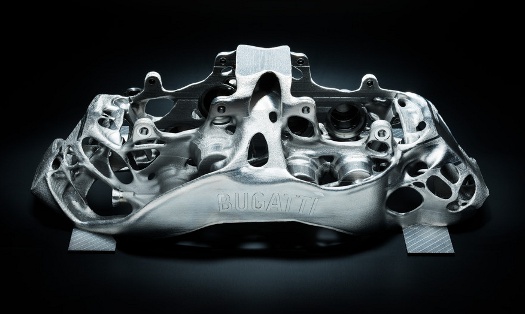
This Bugatti eight-piston monobloc brake caliper is the world's first titanium brake caliper to be produced by a 3D printer and also the largest titanium functional component produced by additive manufacturing. [© 2018 Bugatti Automobiles S.A.S.]
If you're going to plop down $3 million for a hypercar like the Bugatti Chiron and go from 0 to 60 mph in less than 2.5 sec, it better come with a trusty, high-tech way to stop. Luckily, the French luxury automaker already uses the most powerful brakes in the automotive world, which have just been upgraded by incorporating the world's largest titanium 3D-printed brake caliper.
Currently, the 1,479-hp Chiron's brake calipers are forged from a block of high-strength aluminum alloy. With eight titanium pistons on each of the front calipers and six on each of the rear units, these are also the largest brake calipers currently installed on a production vehicle. Based on nature-inspired design principles, the architecture combines minimum weight with maximum stiffness. The design and mode of operation of the brakes also owes a lot to high-end motorsports.
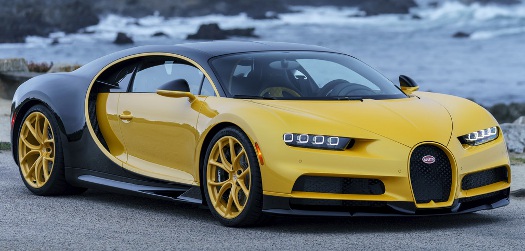
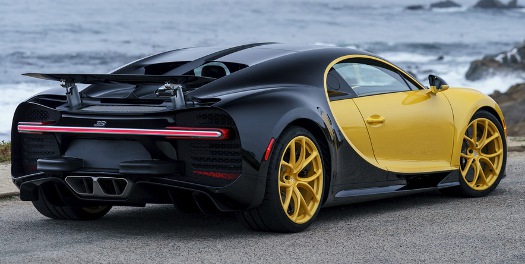
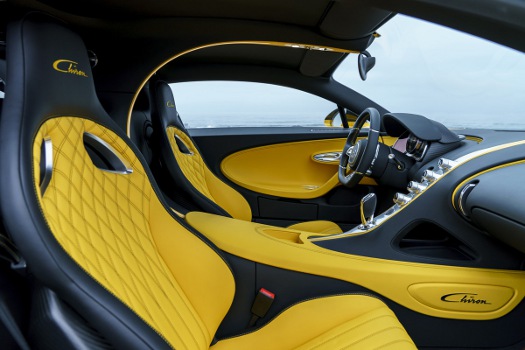
The first Chiron delivered to the United States in 2017 featured a striking black and yellow color scheme. Future models will incorporate new 3D-printed components like the titanium brake calipers Bugatti has recently developed. [© 2017 Bugatti Automobiles S.A.S.]
But the newly developed, 3D-printed titanium brake caliper breaks new ground for future Chirons. This particular titanium alloy, with the scientific designation of Ti6AI4V, is mainly used in the aerospace industry in things like highly stressed undercarriage and wing components or in aircraft and rocket engines. The material offers considerably higher performance than aluminum. Even as a 3D-printed component, this material has a tensile strength of 1,250 N/mm2. This means that a force of slightly more than 125 kg be applied to a square millimeter of this titanium alloy without the material rupturing.
The new titanium brake caliper has finished dimensions of 41 cm (l) x 21 cm (w) x 13.6 cm (h) and weighs only 2.9 kg. In comparison with the aluminum component currently used, which weighs 4.9 kg, Bugatti has reduced the weight of the brake caliper by about 40%, while simultaneously ensuring even higher strength by using the new part.
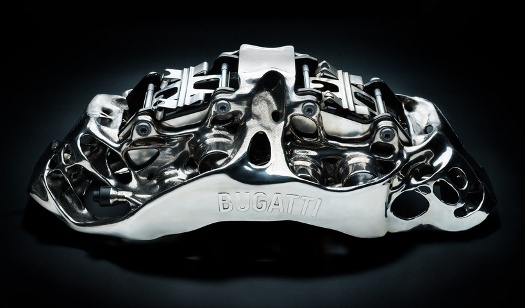
This photo shows the finished Bugatti 3D-printed titanium brake caliper together with pistons and pads. [© 2018 Bugatti Automobiles S.A.S.]
To date, this approach was not feasible, because it is extremely difficult or even impossible to mill or forge components from a titanium block, like you would from aluminum, due to the extreme high strength of the material. High-performance 3D printing solved this problem, and along the way it also opened up the possibility of generating even more complex structures that are significantly stiffer and stronger than would be possible with any conventional production process.
Additive manufacturing technology and research innovator Laser Zentrum Nord in Hamburg, Germany, had the special selective laser melting equipment required to get the job done. "Laser Zentrum Nord is one of many scientific institutes with which we have developed very good cooperation over the years," said Frank Götzke, Head of New Technologies in the Technical Development Department of Bugatti Automobiles S.A.S. "Thanks to the large number of projects completed, mainly for the aviation industry, the institute has comprehensive know-how, especially in the field of titanium processing, and offers mature technology." Over the past few years, the production scientists in Hamburg have received a large number of highly regarded national and international innovation awards for their work in industry.
The development time for the 3D-printed titanium brake caliper was very short. From the first idea to the first printed component, it took only about three months. The basic concept, the strength and stiffness simulations and calculations, and the design drawings were sent to Laser Zentrum Nord by Bugatti as a complete data package. The institute then carried out process simulation, the design of the supporting structures, actual printing, and the treatment of the component. Bugatti was responsible for finishing.
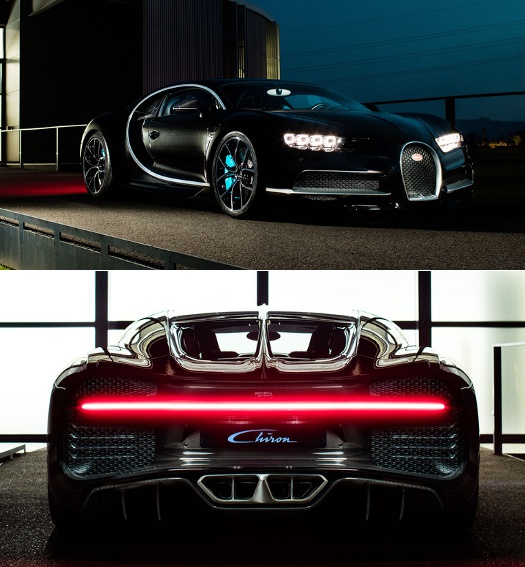
Bugatti delivered 70 Chiron supercars to customers around the world in 2017. According to Motor Trend, the car has an electronically limited top speed of 261 mph but can go much faster. [© 2017 Bugatti Automobiles S.A.S.]
The special 3D printer at Laser Zentrum Nord, which was the largest printer in the world suitable for titanium at the start of the project, is equipped with four 400-W lasers. It takes a total of 45 hours to print a brake caliper. During this time, titanium powder is deposited layer by layer. With each layer, the four lasers melt the titanium powder into the shape defined for the brake caliper. The material cools immediately, and the brake caliper takes shape. The total number of layers required is 2,213. Following the completion of the final layer, the remaining, unmelted titanium powder is removed from the chamber, cleaned, and preserved for reuse in a closed-loop system. What remains in the chamber is a brake caliper, complete with supporting structure, that maintains its shape until it has received stabilizing heat treatment and reached its final strength.
Heat treatment is carried out in a furnace, where the brake caliper is exposed to an initial temperature of 700 deg C, falling to 100 deg C in the course of the process, in order to eliminate residual stress and to ensure dimensional stability. Finally, the supporting structures are removed, and the component is separated from the tray. In the next production stage, the surface is smoothed in a combined mechanical, physical, and chemical process that drastically improves the component's fatigue strength (i.e., the long-term durability of the component in later vehicle operation). Finally, the contours of functional surfaces, such as the piston contact surfaces or threads, are machined in a five-axis milling machine that takes another 11 hours to complete its work.
The result is a delicately shaped component with wall thicknesses between a minimum of only 1 mm and a maximum of 4 mm.
"It was a very moving moment for the team when we held our first titanium brake caliper from the 3D printer in our hands," Götzke remembered. "In terms of volume, this is the largest functional component produced from titanium by additive manufacturing methods. Everyone who looks at the part is surprised at how light it is -- despite its large size. Technically, this is an extremely impressive brake caliper, and it also looks great."
Trials in production vehicles are are scheduled for the first half of this year. By then, the engineers involved aim to shorten production times considerably, especially for machining.

Frank Götzke, Head of New Technologies in the Technical Development Department of Bugatti Automobiles. [© 2018 Bugatti Automobiles S.A.S.]
"Vehicle development is a never-ending process" said Götzke. "In 3D-printing development, Bugatti is the leader in the Volkswagen group. Everyone can and should benefit from our projects. This is also part of Bugatti's role as the Group laboratory for high-tech applications."
Götzke hinted that more 3D-printing feats are already in the works at Bugatti, including producing the longest aluminum component to date made by 3D printing.
Source: Bugatti Automobiles S.A.S.
Published February 2018
Rate this article
View our terms of use and privacy policy
